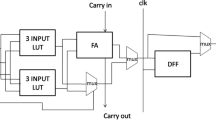Abstract
In this paper we present a fault tolerant (FT) technique for field programmable gate arrays (FPGAs) that is based on incrementally reconfiguring circuits and applications that have been previously placed and routed. Our technique targets both logic faults and interconnect faults, and our algorithms can be applied to either static or run-time reconfigurable FPGAs. The algorithm for reconfiguring designs in the presence of logic faults uses a matching technique. The matching technique requires no preplaced, spare logic resources and is capable of handling groups of faults. Experimental results indicate there is little or no impact on circuit performance for low numbers of reconfigured logic blocks. For interconnect faults, we present a rip-up and reroute strategy. Our strategy is based on reading back the FPGA configuration memory, so no netlist is required for rerouting around faulty resources. Experimental results indicate high incremental routability for low numbers of interconnect faults. We also lay the foundation for applying our approach to yield enhancement.
Similar content being viewed by others
References
Xilinx Inc., http://www.xilinx.com.
Altera Inc., http://www.altera.com.
W. Tsu, K. Macy, A. Joshi, R. Huang, N. Walker, T. Tung, O. Rowhani, V. George, J. Wawrzynek, and A. DeHon, “HSRA:High-Speed, Hierarchical Synchronous Reconfigurable Array,” in ACM Seventh International Symposium on Field-Programmable Gate Arrays, Feb. 1999, pp. 125–134.
N.J. Howard, A.M. Tyrrell, and N.M. Allinson, “The Yield Enhancement of Field-Programmable Gate Arrays,” IEEE Transactions on Very Large Scale Integration (VLSI) Systems, Vol. 2, pp. 115–123, March 1994.
J.M. Emmert and D. K. Bhatia, “Incremental Routing in FPGAs,” in Eleventh Annual IEEE International ASIC Conference, Sept. 1998, pp. 217–221.
J.M. Emmert and D.K. Bhatia, “Partial Reconfiguration of FPGA Mapped Designs with Applications to Fault Tolerance and Yield Enhancement,” in Seventh International Workshop on Field Programmable Logic (FPL97), Aug./Sept. 1997, volume 1304, Springer-Verlag, pp. 141–150.
S.D. Brown, R.J. Francis, J. Rose, and Z.G. Vranesic, Field-Programmable Gate Arrays, Kluwer Academic Publishers, Norwell, MA, 1992.
M. Abramovici, C. Stroud, S. Wijesuriya, C. Hamilton, and V. Verma, “Using Roving STARs for On-Line Test and Diagnosis of FPGAs in Fault-Tolerant Applications,” in Proceedings of the 1999 International Test Conference, Oct. 1999, pp. 973–982.
R. Karri and N. Mukherjee, “Versatile BIST: An Integrated Approach to On-line/Off-line BIST,” in Proceedings of the 1998 International Test Conference, Oct. 1998, pp. 910–917.
F. Lombardi, D. Ashen, X. Chen, and W.K. Huang, “Diagnosing Programmable Interconnect Systems for FPGAs,” in ACM Fourth International Symposium on Field-Programmable Gate Arrays, Feb. 1996, pp. 100–106.
C. Stroud, E. Lee, S. Konala, and M. Abramovici, “Using ILA Testing for BIST in FPGAs,” in Proceedings of the 1996 International Test Conference, Oct. 1996, pp. 68–75.
C. Stroud, E. Lee, and M. Abramovici, “BIST-Based Diagnostics of FPGA Logic Blocks,” in Proceedings of the 1997 International Test Conference, Oct. 1997, pp. 539–547.
J. Lach, W.H. Mangione-Smith, and M. Potkonjak, “Efficiently Supporting Fault Tolerance in FPGAs,” in ACM Sixth International Symposium on Field Programmable Gate Arrays, Feb. 1998, pp. 105–115.
S. Dutt and F. Hanchek, “REMOD: A New Methodology for Designing Fault-Tolerant Arithmetic Circuits,” IEEE Transactions on Very Large Scale Integration (VLSI) Systems, Vol. 5, pp. 34–56, March 1997.
F. Hanchek and S. Dutt, “Methodologies for Tolerating Cell and Interconnect Faults in FPGAs,” IEEE Transactions on Computers, Vol. 47, pp. 15–33, Jan. 1998.
G.H. Chapman and B. Dufort, “Laser Correcting Defects to Create Transparent Routing for Large Area FPGAs,” in ACM Fifth International Symposium on Field-Programmable Gate Arrays, Feb. 1997, pp. 17–23.
J.L. Kelly and P.A. Ivey, “A Novel Approach to Defect Tolerant Design forSRAM Based FPGAs,” in ACM Second International Workshop on Field-Programmable Gate Arrays, Feb. 1994.
S. Durand and C. Piguet, “FPGA with Selfrepair Capabilities,” in ACM Second International Workshop on Field-Programmable Gate Arrays, Feb. 1994.
F. Hatori, T. Sakurai, K. Sawada, M. Takahashi, M. Ichida, M. Uchida, I. Yoshii, Y. Kawahara, T. Hibi, Y. Saeki, H. Muraga, A. Tanaka, and K. Kanzaki, “Introducing Redundancy in Field Programmable Gate Arrays,” in Proceedings of the IEEE International Conference on Custom Integrated Circuits, 1993, pp. 7.1.1–7.1.4.
A. Mathur, K.C. Chen, and C.L. Liu, “Re-engineering of Timing Constrained Placements for Regular Architectures,” in IEEE/ACM International Conference on Computer Aided Design, Nov. 1995, pp. 485–490.
C. Carruthers, B. Fawcett, C. Patterson, and B. Wilkie, “The XC6200: A Microprocessor-Oriented FPGA,” in Proceedings of the 4th CanadianWorkshop on Field-Programmable Devices, May 1996, pp. 91–96.
F.T. Leighton and P.W. Shor, “Tight Bounds for Minimax Grid Matching with Applications to Average Case Analysis of Algorithms,” in Proceedings of the Symposium on Theory of Computing, May 1986, pp. 91–103.
C. Papadimitriou and K. Steiglitz, Combinatorial Optimization, Prentice Hall Publishers, Englewood Cliffs, NJ, 1998.
S. Even, Graph Algorithms, Computer Science Press, NewYork, 1979.
D. Bhatia and A. Chowdhary, “A Multi-Terminal Net Router for Field-Programmable Gate Arrays,” VLSI Design, Vol. 4, pp. 1–10, 1996.
S.D. Brown, J. Rose, and Z.G. Vranesic, “A Detailed Router for Field-Programmable Gate Arrays,” IEEE Transactions on Computer Aided Design, Vol. 11, pp. 620–628, May 1992.
Xilinx Inc., The Programmable Logic Data Book, Xilinx, 2100 Logic Drive, San Jose, CA 95124–3400, 1995.
Rights and permissions
About this article
Cite this article
Emmert, J.M., Bhatia, D.K. A Fault Tolerant Technique for FPGAs. Journal of Electronic Testing 16, 591–606 (2000). https://doi.org/10.1023/A:1008365019152
Issue Date:
DOI: https://doi.org/10.1023/A:1008365019152




